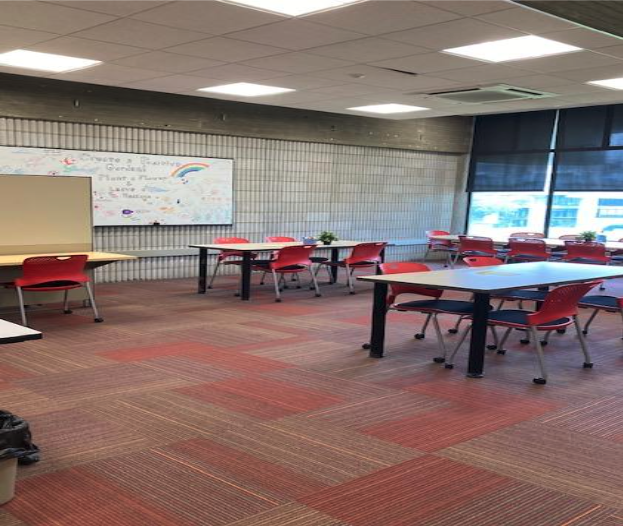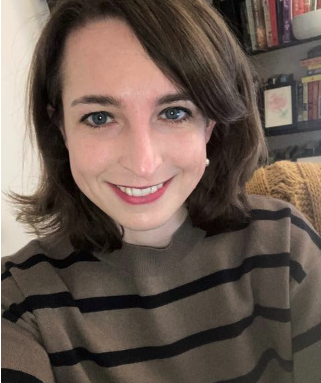My context for developing a multiliteracy center was unique and rather complicated. When I was tasked in fall 2017 with building a new student support center for UMass Dartmouth’s campus, I was prohibited from using the word “writing” in the name of this center. I will not go at length into the reasons for this, as I have had the opportunity to explain via a recent publication (see Botvin & Buck, 2024) but suffice it to say, the name and the purpose of this new center had to be deliberate and well-justified.

The perspectives shared in the seminal 2012 Praxis piece “The Idea of a Multiliteracy Center: Six Responses” reinforced that multiliteracy was an appropriate, if somewhat fraught, designator for the type of center I wanted to build. This term signaled to me an awareness of the twenty-first century conditions for writing as well as emphasized that those who utilized the center would themselves be multiliterate. I envisioned a space that was endlessly expansive, where students could not only work on traditional written assignments and multimodal texts but where they could also communicate using a plurality of literacies and modalities. At the time, I was finalizing my book project Open-Access, Multimodality, and Writing Center Studies (Palgrave, 2018) that focused on the ways that writing center practitioners engage with new technologies both in scholarship and in praxis. I thus felt well-prepared to lead this new center in what I believed to be an important and innovative direction.
Did my vision come to fruition? In some ways, yes, and in other ways, no. Though as I’ll clarify below, that the reality didn’t match the expectation is not an entirely bad thing.
I write this piece amidst a significant personal transition. I left my role as founding director of the center at UMass Dartmouth and, in fall 2024, will be taking on the directorship of the writing center at Fordham University. I am grateful for this space to reflect on what it means to build (and leave) a multiliteracy center–perhaps especially significant as we enter a new technological moment that will certainly have great import for writing center professionals.
Reflection Point #1: (In)Accessibility
When the Multiliteracy and Communication Center opened at UMassD in fall 2018, one of the biggest challenges we faced was effectively conveying to the campus what, exactly, we did there. The conclusion of “The Idea of a Multiliteracy Center” hints at the difficulties that one might encounter when building such a center from the ground up, specifically that “starting a multiliteracy center from scratch amounts to re-inventing the wheel. The challenge, then, is not (only) to cram multiliteracy practices into an already overwhelmed learning ecology. Instead, the challenge is to convince stakeholders (including students, faculty, and administrators) that universities will serve learners more effectively if they establish multiliteracy centers.” We dove into a significant on-campus marketing campaign to clarify that multiliteracy stood at the heart of our purpose. We quoted the New London group on our website, defined multiliteracy in class visits and presentations, and increased tutor-training initiatives to respond to multimodal texts. Nevertheless our name proved challenging. We had folks across campus refer to us variously as the Multi-media Center, the Multicultural Center, the Multimodality Center, and various other permutations of Multi-[fill in the blank here].
It is important to acknowledge that the word multiliteracy is not particularly accessible. I teach writing for public relations and quickly realized that the center essentially had a PR and name recognition problem. The opportunity arose in fall 2021 to change our name, as well as incorporate the word writing in a way that had not been previously permitted, and so we opted to become the Writing and Multiliteracy Center. This name shift did help to clarify our purpose, but aspiring multiliteracy center directors might want to think about developing a robust marketing campaign that renders the term multiliteracy more legible, in conjunction with adopting Allison Hitt’s important recommendations about ensuring multiliteracy centers’ greater accessibility. Walking into a writing center to seek support is already a challenging enough endeavor; if it is not clear why that center exists or what its purpose is, that hurdle becomes even more insurmountable.
Reflection Point #2: Institutional Support
In “Taking Stock: Multimodality in Writing Center Users’ Texts” Jennifer Grouling and Jackie Grutsch McKinney assessed a sample of students’ work brought to the writing center at Ball State University and found that fewer than 10% of these assignments were multimodal. The ability to support multimodal assignments was one of the main initial objectives of the center at UMassD, and having trained under the wonderful Drs. Grouling and McKinney at Ball State, I anticipated that we would see a similar proportion of multimodal assignments at UMassD. Grouling and Grutsch McKinney conclude that any quantity of multimodal work brought to a center is ultimately a success, as they “believe that college should be a place where student practice the sort of communication that students will enact after college in their professional, civic, personal, and academic writing, and those communications will likely be multimodal” 66).
This assertion undoubtedly motivated my objective in designing the Multiliteracy and Communication Center but what I failed to recognize is that the ability to successfully offer support for certain multimodal texts is greatly contingent upon institutional standards and resources. To work on, for example, an assignment that necessitates the use of a program like iMovie, one must have, at minimum:
- a well-functioning computer that will support iMovie
- a subscription for that software
- tutoring staff that have been trained to give feedback on iMovie assignments
- a curriculum that encourages students to use tools like iMovie.
Throughout my time at UMass Dartmouth, our center variously met one or two of these conditions, and I would suspect most centers, excepting those that are particularly well-supported and funded, would report similar circumstances.
My point is that writing center work should always reflect the goals and needs of the particular institution in which it is situated. The extent to which you can sustainably foster support for multimodal assignments depends significantly on the level of assistance for this objective that the institution grants or requires. I ultimately dropped from training a unit on The Non-Designer’s Design Book, which I used for framing responses to multimodal texts, in favor of a unit on asynchronous tutoring strategies. I found that our focus necessarily evolved in response to the students’ needs–something that the pandemic exacerbated. Holding onto multimodality as a critical aspect of a multiliteracy center perhaps does a disservice to the complicated communicative moment that we find ourselves in. More on this, below.
Reflection Point #3: Emphasizing the Human
My current research project, the edited collection Writing Centers and AI: Generating Early Conversations is still in its early stages, but a major theme that I am seeing from our contributors is a need for writing centers to be visible in showcasing what we can offer to writers that advanced Large Language Models (LLMs) like ChatGPT cannot.
Writing centers, if they are going to survive the innovations of AI, need to focus on our biggest assets: the people who staff our centers. In reflecting on this, I want to call attention to a piece from The Peer Review, Writing Center: The Musical by Jollina Simpson and Hugo Virrueta. I had the opportunity to see Jollina and Hugo stage a reading of this piece at the 2019 IWCA/NCPTW conference in Columbus, Ohio and I strongly encouraged them to submit to this special issue of The Peer Review. The pandemic (sadly) prohibited their planned full staging of the musical, but I remember being struck at the reading by how well both their musical and, eventually, their published piece echoed my ideal vision for a multiliteracy center. The center Jollina and Hugo brought to life was multilingual and multimodal, it was complicated, and it was so profoundly human. And yes, people occasionally broke out into song.
It is certainly the people that I will miss most at UMass Dartmouth.
I want to conclude with a picture that I took on my last day on UMass Dartmouth’s campus. It is a photo of one of our whiteboards in the Writing and Multiliteracy Center’s space.
On this whiteboard, a tutor-in-training opted to draw a flower and entreated others to contribute their own drawings and share positive messages. The whiteboard was completely filled within days.
I shudder to think what the AI-generated version of this positive flower garden might look like but my point is that writing centers, now more than ever, need to emphasize the power of human connections for and to the writing process.
I am not certain that multiliteracy, as useful a word that it can be, is the best term to describe the essential human component that is critical to our labor(s) and our future(s). We must focus on bringing writers to our spaces in ways that are accessible, visible, and complex. The time has passed for us to signal our attentiveness to fancy technologies. We need to emphasize that we provide all that the technologies cannot.
References
Balester et. al. (2012). The idea of a multiliteracy center: Six responses. Praxis: A Writing Center Journal, 9(2). http://www.praxisuwc.com/baletser-et-al-92
Botvin, J. & Buck, E. (2024). A tale of two writing centers: Navigating fraught institutional legacies. In E. Kleinfield, S. Lee, & J. Prebel (Eds.), Disruptive stories: Amplifying voices from the writing center margins (pp.49-65). Utah State University Press.
Buck, E. H. (2018). Open-access, multimodality, and writing center studies. Palgrave Macmillan.
Buck, E. & Botvin, J. (2024). Writing Centers and AI: Generating Early Conversations: An Edited Collection.
Grouling, J., & Grutsch McKinney, J. (2016). Taking stock: Multimodality in writing center users’ texts. Computers and Composition, 41, 56–67. https://doi.org/10.1016/j.compcom.2016.04.003
Hitt, A. (2012). Access for all: The role of dis/ability in multiliteracy centers. Praxis: A Writing Center Journal, 9(2). http://www.praxisuwc.com/hitt-92
The new london group. (1996). A pedagogy of multiliteracies: Designing social futures. Simon Fraser University. https://www.sfu.ca/~decaste/newlondon.htm
Simpson, J. & Viruetta, H. (2020). Writing center, the musical. The Peer Review Journal, 4(2). https://thepeerreview-iwca.org/issues/issue-4-2/writing-center-the-musical/
Williams, R. (2019). The non-designer’s Design book. Peachpit Press.

